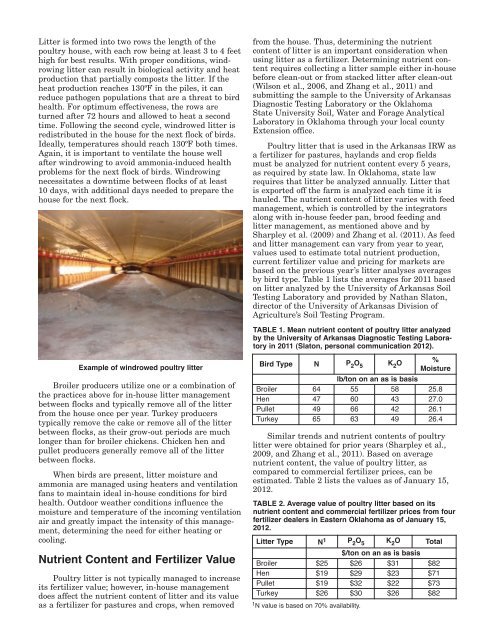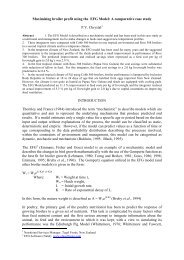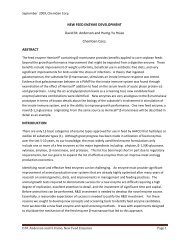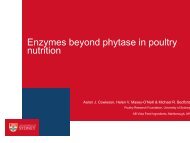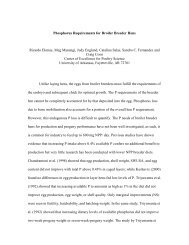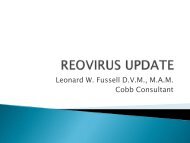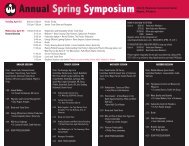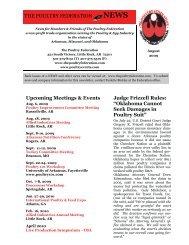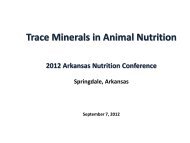Poultry Litter Management in the Illinois River Watershed of ...
Poultry Litter Management in the Illinois River Watershed of ...
Poultry Litter Management in the Illinois River Watershed of ...
You also want an ePaper? Increase the reach of your titles
YUMPU automatically turns print PDFs into web optimized ePapers that Google loves.
<strong>Litter</strong> is formed <strong>in</strong>to two rows <strong>the</strong> length <strong>of</strong> <strong>the</strong>poultry house, with each row be<strong>in</strong>g at least 3 to 4 feethigh for best results. With proper conditions, w<strong>in</strong>d row<strong>in</strong>g litter can result <strong>in</strong> biological activity and heatproduction that partially composts <strong>the</strong> litter. If <strong>the</strong>heat production reaches 130ºF <strong>in</strong> <strong>the</strong> piles, it canreduce pathogen populations that are a threat to birdhealth. For optimum effectiveness, <strong>the</strong> rows areturned after 72 hours and allowed to heat a secondtime. Follow<strong>in</strong>g <strong>the</strong> second cycle, w<strong>in</strong>drowed litter isredistributed <strong>in</strong> <strong>the</strong> house for <strong>the</strong> next flock <strong>of</strong> birds.Ideally, temperatures should reach 130ºF both times.Aga<strong>in</strong>, it is important to ventilate <strong>the</strong> house wellafter w<strong>in</strong>drow<strong>in</strong>g to avoid ammonia<strong>in</strong>duced healthproblems for <strong>the</strong> next flock <strong>of</strong> birds. W<strong>in</strong>d row<strong>in</strong>gnecessitates a downtime between flocks <strong>of</strong> at least10 days, with additional days needed to prepare <strong>the</strong>house for <strong>the</strong> next flock.from <strong>the</strong> house. Thus, determ<strong>in</strong><strong>in</strong>g <strong>the</strong> nutrientcontent <strong>of</strong> litter is an important consideration whenus<strong>in</strong>g litter as a fertilizer. Determ<strong>in</strong><strong>in</strong>g nutrient contentrequires collect<strong>in</strong>g a litter sample ei<strong>the</strong>r <strong>in</strong>housebefore cleanout or from stacked litter after cleanout(Wilson et al., 2006, and Zhang et al., 2011) andsubmitt<strong>in</strong>g <strong>the</strong> sample to <strong>the</strong> University <strong>of</strong> ArkansasDiagnostic Test<strong>in</strong>g Laboratory or <strong>the</strong> OklahomaState University Soil, Water and Forage AnalyticalLaboratory <strong>in</strong> Oklahoma through your local countyExtension <strong>of</strong>fice.<strong>Poultry</strong> litter that is used <strong>in</strong> <strong>the</strong> Arkansas IRW asa fertilizer for pastures, haylands and crop fieldsmust be analyzed for nutrient content every 5 years,as required by state law. In Oklahoma, state lawrequires that litter be analyzed annually. <strong>Litter</strong> thatis exported <strong>of</strong>f <strong>the</strong> farm is analyzed each time it ishauled. The nutrient content <strong>of</strong> litter varies with feedmanagement, which is controlled by <strong>the</strong> <strong>in</strong>tegratorsalong with <strong>in</strong>house feeder pan, brood feed<strong>in</strong>g andlitter management, as mentioned above and bySharpley et al. (2009) and Zhang et al. (2011). As feedand litter management can vary from year to year,values used to estimate total nutrient production,current fertilizer value and pric<strong>in</strong>g for markets arebased on <strong>the</strong> previous year’s litter analyses averagesby bird type. Table 1 lists <strong>the</strong> averages for 2011 basedon litter analyzed by <strong>the</strong> University <strong>of</strong> Arkansas SoilTest<strong>in</strong>g Laboratory and provided by Nathan Slaton,director <strong>of</strong> <strong>the</strong> University <strong>of</strong> Arkansas Division <strong>of</strong>Agriculture’s Soil Test<strong>in</strong>g Program.TABLE 1. Mean nutrient content <strong>of</strong> poultry litter analyzedby <strong>the</strong> University <strong>of</strong> Arkansas Diagnostic Test<strong>in</strong>g Laboratory<strong>in</strong> 2011 (Slaton, personal communication 2012).Example <strong>of</strong> w<strong>in</strong>drowed poultry litterBroiler producers utilize one or a comb<strong>in</strong>ation <strong>of</strong><strong>the</strong> practices above for <strong>in</strong>house litter managementbetween flocks and typically remove all <strong>of</strong> <strong>the</strong> litterfrom <strong>the</strong> house once per year. Turkey producerstypically remove <strong>the</strong> cake or remove all <strong>of</strong> <strong>the</strong> litterbetween flocks, as <strong>the</strong>ir growout periods are muchlonger than for broiler chickens. Chicken hen andpullet producers generally remove all <strong>of</strong> <strong>the</strong> litterbetween flocks.When birds are present, litter moisture andammonia are managed us<strong>in</strong>g heaters and ventilationfans to ma<strong>in</strong>ta<strong>in</strong> ideal <strong>in</strong>house conditions for birdhealth. Outdoor wea<strong>the</strong>r conditions <strong>in</strong>fluence <strong>the</strong>moisture and temperature <strong>of</strong> <strong>the</strong> <strong>in</strong>com<strong>in</strong>g ventilationair and greatly impact <strong>the</strong> <strong>in</strong>tensity <strong>of</strong> this management,determ<strong>in</strong><strong>in</strong>g <strong>the</strong> need for ei<strong>the</strong>r heat<strong>in</strong>g orcool<strong>in</strong>g.Nutrient Content and Fertilizer Value<strong>Poultry</strong> litter is not typically managed to <strong>in</strong>creaseits fertilizer value; however, <strong>in</strong>house managementdoes affect <strong>the</strong> nutrient content <strong>of</strong> litter and its valueas a fertilizer for pastures and crops, when removedBird Type N P 2 O 5 K 2 O%Moisturelb/ton on an as is basisBroiler 64 55 58 25.8Hen 47 60 43 27.0Pullet 49 66 42 26.1Turkey 65 63 49 26.4Similar trends and nutrient contents <strong>of</strong> poultrylitter were obta<strong>in</strong>ed for prior years (Sharpley et al.,2009, and Zhang et al., 2011). Based on averagenutrient content, <strong>the</strong> value <strong>of</strong> poultry litter, ascompared to commercial fertilizer prices, can beestimated. Table 2 lists <strong>the</strong> values as <strong>of</strong> January 15,2012.TABLE 2. Average value <strong>of</strong> poultry litter based on itsnutrient content and commercial fertilizer prices from fourfertilizer dealers <strong>in</strong> Eastern Oklahoma as <strong>of</strong> January 15,2012.<strong>Litter</strong> Type N 1 P 2 O 5 K 2 O Total$/ton on an as is basisBroiler $25 $26 $31 $82Hen $19 $29 $23 $71Pullet $19 $32 $22 $73Turkey $26 $30 $26 $821 N value is based on 70% availability.


